TImageEnProc.GetDominantColor
Declaration
function GetDominantColor(var Color: TRGB): Double; overload;function GetDominantColor(var Color: TColor): Double; overload;
function GetDominantColor(var Color: TColor; ExcludeColors: array of TColor): Double; overload;
function GetDominantColor(var DominantColors: array of TColor; Count: Integerr;
ExcludeLighterThan: Double = -1;
ExcludeDarkerThan: Double = -1): Integer; overload;
Description
Return the dominant (most common) color in the image.Color will contain the dominant color, and the result will return the percentage of the image with that color (value range is 0.0 to 100.0).
You can use the final overload to get a list of the dominant colors in an image (Ordered from most used downward. Result will be the number of colors returned, which should match Count, except for images with few colors). Ensure you set the length of the array to Count (i.e. using SetLength( DomColors, Count ) before calling the method.
To exclude very light or dark colors (based on HSL lightness), specify values for ExcludeLighterThan (0-255) and/or ExcludeDarkerThan (0-255). Remember that light values will be close to 255 (i.e. white would be exactly 255) and dark values will be close to 0 (i.e. black would be exactly 0).
Note:
◼Works only with ie24RGB and ie1g pixel formats
◼Will process either the whole image or a rectangular selection. Other selection types are ignored
◼It is best not used with transparent images as colors in transparent areas (that are not visible) will affect the result
◼You can output the palette as an image using IEDrawColorPalette, or show the palette to the user using IEPromptForColor
◼When using GetDominantColor to determine whether an image is blank, it can help to reduce the color depth or apply thresholding
Demos
 | Demos\ImageAnalysis\Histogram\Histogram.dpr |
 | Demos\ImageEditing\EveryMethod\EveryMethod.dpr |
 | Demos\ImageEditing\CompleteEditor\PhotoEn.dpr |
Examples
perc := ImageEnView1.Proc.GetDominantColor(cl);If Round( perc ) = 100 then
ShowMessage('The image is blank!');
// Test if the image is blank (with 1% threshold and ignoring the border area)
threshold := 1.0; // Allow 1% of image to be a different color
borderPerc := 10; // Border area is 10% of width/height
ImageEnView1.SelectionBase := iesbBitmap;
ImageEnView1.Select( MulDiv( ImageEnView1.IEBitmap.Width, borderPerc, 100 ),
MulDiv( ImageEnView1.IEBitmap.Height, borderPerc, 100 ),
MulDiv( ImageEnView1.IEBitmap.Width, 100 - borderPerc, 100 ),
MulDiv( ImageEnView1.IEBitmap.Height, 100 - borderPerc, 100 ));
if ImageEnView1.Proc.GetDominantColor(cl) >= 100 - threshold then
ShowMessage('Image is blank!')
else
ShowMessage('Image is NOT blank!');
ImageEnView1.Deselect();
// Show the dominant color of the image
// Display the most common color in the image (and its percentage of the image)
var
d: Double;
rgb: TRGB;
begin
d := ImageEnView1.Proc.GetDominantColor( rgb );
lblDominantColor.Caption := format( 'Dominant Color (%d%%): %s', [ Round( d ), ColorToHex( TRGB2TColor( rgb )) ]);
IEColorButton1.SelectedColor := TRGB2TColor( rgb );
end;
// Display the ten most used colors
var
i, cnt: Integer;
domColors : array of TColor;
c: TColor;
begin
Memo1.Clear();
SetLength( domColors, 10 );
cnt := ImageEnView1.Proc.GetDominantColor( domColors, 10 );
if cnt < 10 then
SetLength( domColors, cnt ); // Image had less than ten colors
for i := 0 to cnt - 1 do
Memo1.Lines.Add( ColorToHex( domColors[i] ));
// Show palette to users
IEPromptForColor( c, domColors, cnt );
end;
// Alternative method to display the ten most used colors
var
i: Integer;
usedColors : array[1..10] of TColor;
c: TColor;
dd: Double;
begin
Memo1.Clear();
// Reset used color array
for i := Low(usedColors) to High(usedColors) do
usedColors[i] := clNone;
for i := 1 to 10 do
begin
dd := ImageEnView1.Proc.GetDominantColor( c, usedColors );
usedColors[ i ] := c;
Memo1.Lines.Add( format( '%s (%d%%)', [ ColorToHex( c ), Round( dd ) ]));
end;
// Show palette to users
IEPromptForColor( c, usedColors, 10 );
end;
// Load test image
ImageEnView1.IO.LoadFromFile( 'D:\TestImage.jpg' );
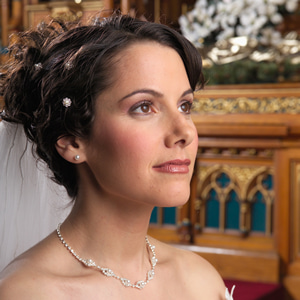
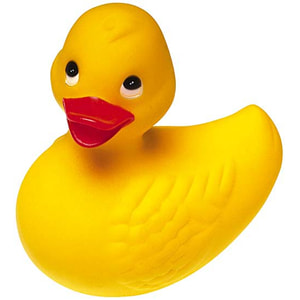
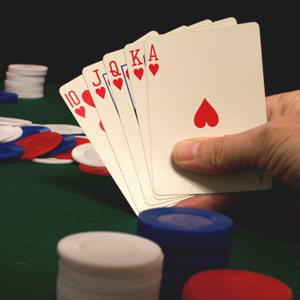
// Return the most common color in the image (and its percentage of the image)
d := ImageEnView1.Proc.GetDominantColor( rgb );
s := format( 'Dominant Color (%d%%): %s', [ Round( d ), ColorToHex( TRGB2TColor( rgb )) ]);
ImageTest1.jpg: Dominant Color (0%): #060606
ImageTest2.jpg: Dominant Color (39%): #FFFFFF
ImageTest3.jpg: Dominant Color (20%): #1C1C1C
// Show in ImageEnView2 the 64 most common colors of the image in ImageEnView1
var
domColors: Array of TColor;
count: Integer;
begin
SetLength( domColors, 64 );
count := ImageEnView1.Proc.GetDominantColor( domColors, v1 );
if count < v1 then
SetLength( domColors, count ); // Image had less than 64 colors (only needed if you want to do something with domColors)
IEDrawColorPalette( ImageEnView2.IEBitmap, domColors, 30, 30, 8, clWhite, clBlack, count );
ImageEnView2.Update();
end;
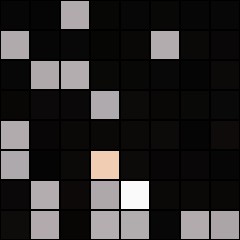
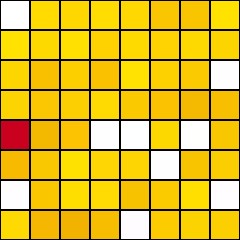
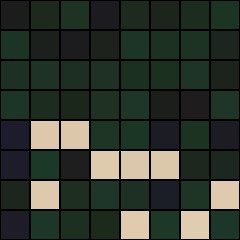
See Also
◼CreateRGB◼TRGB2TColor
◼TColor2TRGB
◼ColorToHex